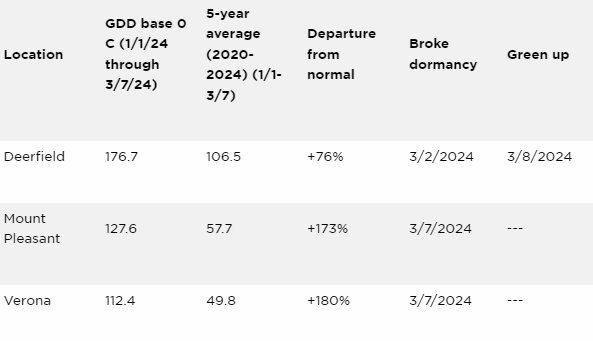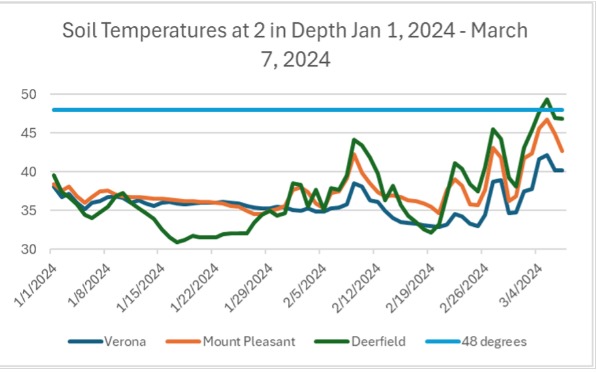By Monica Jean and Jenna Falor
Wheat growth and development
Most of Michigan’s Lower Peninsula has experienced warmer than normal temperatures this winter and into early March. Many growers are reporting that it appears their wheat has greened up and is starting to grow. This raises questions about potential for winterkill, late season frost, impact on yield potential, timing of nitrogen, herbicide applications and other items.
First, let’s understand wheat growth and development. Wheat hardens off as temperatures cool in the fall and remain dormant over the winter months. As temperatures warm up and daylength increases in the spring, wheat will break dormancy, green up and begin to grow. The growing point for wheat will remain below the soil surface until mid-spring. Soil temperature is a good estimate of the crown temperature when evaluating potential risk of winterkill from cold temperatures on wheat.
A phyllochron is the interval of time it takes for a new leaf (tiller) to develop. It generally takes about 100 growing degree days (GDD) per phyllochron. GDDs for wheat development are calculated differently than for corn or other crops. For wheat, the number of GDDs is calculated using degrees Celsius with a base temperature of zero. Simply, it is the average of the daily high and low temperatures. For example, if the low is 0 C and the high is 10 C, the GDD for that day is 5[(0+10)/2].
There are a couple rules of thumb for determining when wheat will break dormancy and when it will green up and start to grow. First, warming to a soil temperature of 48 degrees Fahrenheit is an indicator that wheat may have broken dormancy. Second, seven consecutive days with GDDs above zero is also an indicator that wheat has broken dormancy. Generally, these two rules of thumb occur on the same day or within a few days of each other. For green up to occur, you need seven days in a row where there is at least 5 GDDs each day.
The data in Table 1 shows the GDD accumulation from Jan. 1 to March 7 for three locations in Michigan. It also shows the five-year average and departure from normal. All three locations show higher GDD accumulations in 2024 compared to the past five years ranging from 76% to 180% higher GDDs. Based on the rules of thumb listed above, wheat has broken dormancy at all three locations (see dates in table), but green up has only occurred in the southernmost location of Deerfield. However, the other locations are very close.
If you follow the soil temperature rule of thumb, it also shows that Deerfield did break 48 F soil temperature, indicating it has broken dormancy (Figure 1). The other locations are close, but not quite there yet.
Table 1. Growing degree day (GDD) accumulations, departure from normal and wheat growth and development for selected locations in Michigan in 2024.


Figure 1. Soil temperature taken at the 2-inch depth for selected locations in Michigan in 2024.
The abnormally early start to the season has raised several questions from wheat producers. We will try to answer them here.
Clover frost seed considerations
Frost seeding clover is still a good option. There will be frosts and rainfall to work the seed in. Usually this is done on frozen ground to limit damage to the crop, but if field conditions permit, it is still a good idea to frost seed clover. Take a look at the article “Frost seeding red clover into winter wheat” for details on how to frost seed clover. For additional information on cover crop termination, please refer to our bulletin on cover crop termination.
Nitrogen management
Just because fields are starting to green up and field conditions may be amenable to applying fertilizer doesn't mean it is time to go out and put on nitrogen. It is still too early and the risk of loss is high. Scout your fields and determine how many tillers each plant has. If you have two to three tillers now, wait until Feekes 4-5 to put on your nitrogen. If you do not have two to three tillers, go ahead and put on 30-40 pounds of actual nitrogen (N) now to help stimulate tillering. Remember, with UAN, 25% of the nitrogen is already in the nitrate form.
Herbicide
A good rule to follow is to apply herbicides to wheat when the average temperature is 50 F and there has not been a frost in the past two days, nor is there frost forecasted for the next two days. We have had a few days that meet these criteria. Before making herbicide applications, make sure to scout your field to make sure winter annuals are starting to grow. Applications at this time will likely be too early for good control.
Pest concerns
There have been questions raised about how the warm temperatures will impact pest populations such as aphids. The concern is that insect pests may have survived the winter because it didn’t get cold enough. It is too hard to tell right now what will happen with pest populations, so the best advice is to scout your fields regularly and pay attention. Participate in programs like Michigan State University Extension’s Field Crops Virtual Breakfast Series to find out what current conditions are and get weekly updates.
Impacts on yield potential
Growers and news reporters alike have asked the question what the warm winter will do to yield potential in wheat. The honest answer is it is too early to tell. One could speculate that warmer temperatures could increase yield potential as wheat will likely start growing earlier in the season, but there are still too many unknowns. Rainfall (or lack thereof), disease problems, insect problems, high temperatures during flowering and grain fill and the amount of solar radiation are factors that will affect the final yield of the crop.
Bottomline is that even though wheat was planted later than optimal in some locations, the wheat crop generally looks good in Michigan. The warmer temperatures last fall allowed for tiller development when normally that wouldn’t happen. So, there is good potential in this wheat crop, but it is still way too early to tell for sure what yields will be.
Source : msu.edu